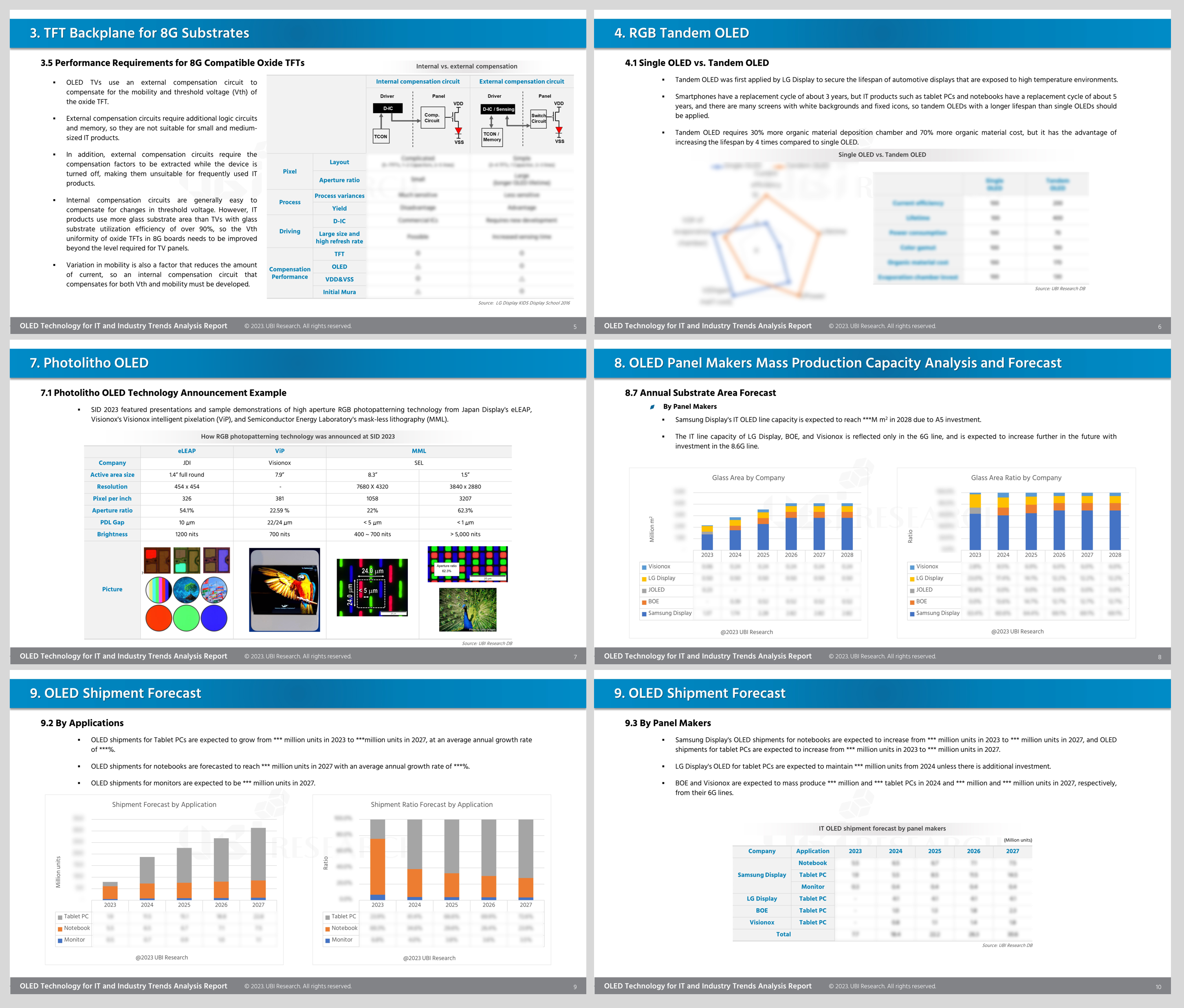Reports
IT OLED Technology and Industry Trend Analysis Report
₩5,000,000
October 19, 2023
PDF(79P)Introduction
OLED market opens in IT devices as well
The OLED industry, which has been focused on smartphones, watches, and TVs, is also planning to expand its reach into the monitor, laptop, and tablet PC markets. OLED for IT requires similar brightness to OLED for TV, but requires low power consumption characteristics similar to OLED for mobile devices. In addition, OLED for IT must be produced with 8.6G equipment, not 6G equipment used to manufacture smartphone panels, to ensure profitability.
LTPO-TFT and oxide TFT will be used as TFTs to manufacture OLEDs with low power consumption. For smartphone OLED, there is no problem for LTPO-TFT manufacturing with 6G equipment, but it is difficult to use 8.6G glass due to limitations of ELA equipment. On the other hand, when using oxide TFT, internal compensation technology is not yet sufficiently developed, so external compensation is required, which requires the use of more drive ICs and also has the disadvantage of widening the bezel.
The OLED structure will be a 2stack OLED structure with a higher brightness than a single stack. Encapsulation is applied by TFE.
There are four companies preparing to produce OLED for IT using 8.6G equipment such as Samsung Display, LG Display, BOE, and Visionox. Each company’s production strategy is different.
Samsung Display is already producing OLED for laptops and tablet PCs using 5.5G and 6G equipment, and has also begun ordering additional 8.6G equipment. LG Display is also preparing to produce OLED for foldable notebooks and tablet PCs with 6G equipment. Visionox is developing a process for patterning OLED using photolithography technology instead of FMM and is preparing to invest in facilities. BOE is also considering ordering 8.6G IT OLED equipment.
The success of the IT OLED market will be determined by which TFT and OLED structure will be used.
‘IT OLED Technology and Industry Trend Analysis Report’ provides a detailed analysis of various technologies that will determine IT OLED performance, yield, and manufacturing cost. By closely analyzing the technologies needed to manufacture high-performance TFTs and OLEDs and the challenges that need to be solved, it will serve as a guideline that tells companies in the OLED industry what to prepare.
In addition, the growth potential of the OLED market for IT which will succeed the OLED market for mobile devices and TVs is presented.
Contents
2. LTPO TFT Backplane
2.1 LTPS TFT, Oxide TFT and LTPO TFT Comparison
2.2 Comparing LTPS TFT Panel and LTPO TFT Panel Performance
2.3 How LTPO TFT Panels Have Low Power Consumption
2.4 Products with LTPO TFT
2.5 LTPO TFT Producer Status
2.6 LTPO TFT Pixel Circuit Performance by Vendor
2.7 LTPO TFT Manufacturing Cost Issues
2.8 Low-cost LTPO TFT Technology
3. TFT Backplane for 8G Substrates
3.1 LTPO TFT Fabrication
3.2 Oxide TFT Development Status
3.3 8G Ready IGZO Target Suppliers
3.4 Need for High Mobility Oxide TFTs
3.5 Performance Requirements for 8G Compatible Oxide TFTs
3.6 Oxide TFT Internal Compensation Circuit for IT Products
4. RGB Tandem OLED
4.1 Single OLED vs. Tandem OLED
4.2 Tandem OLED Device Characteristics
4.3 Single OLED and Tandem OLED Device Structures
4.4 Issues with Tandem OLED
5. Color Filter on Encapsulation
5.1 The Need for COE Technology
5.2 Compare the Characteristics of Polarizer-applied and COE Panels
5.3 COE Process
5.4 COE Development by Panel Makers
6. Hybrid OLED
6.1 Advantages of Hybrid OLED
7. Photolitho OLED
7.1 Photolitho OLED Technology Announcement Example
7.2 Photolitho OLED Development Status by Panel Company
7.3 What Do Photolitho OLED Technologies Have in Common?
7.4 Photolitho OLED Key Patents
8. OLED Panel Makers Mass Production Capacity Analysis and Forecast
8.1 Samsung Display
8.2 LG Display
8.3 BOE
8.4 TCL CSOT
8.5 Visionox
8.6 IT OLED Line Capacity by Panel Makers
8.7 Annual Substrate Area Forecast
9. OLED Shipment Forecast
9.1 Total
9.2 By Applications
9.3 By Panel Makers
Report Sample
Previous report
Related Products
-

Foldable & Slidable OLED Technology and Market Outlook
₩6,000,000January 2, 2024
PDF(111P)Foldable OLED technology, which started in the smartphone market, is also sprouting up in the notebook market. Foldable OLED technology has the advantage that the entire front of a smartphone or notebook can be configured as a screen, and since the screen can be folded, it is a product that enhances portability. Therefore, it will become an essential product in the increasingly sophisticated information age.
-

Small Sized AMOLED Manufacturing Process Report Ver. 6
₩4,000,000March 8, 2024
PDF(218P)The Small Sized AMOLED Manufacturing Process Report covers the manufacturing process for each type of TFT, including LTPS and LTPO TFT, as well as OLED structure and manufacturing process, inspection process, and module manufacturing process.
In this small sized AMOLED manufacturing process report, the Galaxy Z Fold5 structure and module process have been updated for the small OLED manufacturing process. In addition, the eLEAP process and SEL’s photolithography process, which are photolithography OLED processes that have attracted great attention as high-resolution microdisplay OLED manufacturing processes, have been newly added or updated.
This report is a must-read for display companies to understand the AMOLED manufacturing process from TFT substrate to module manufacturing. -

Middle and Large Sized AMOLED Manufacturing Process Report Ver. 6
₩4,000,000March 8, 2024
PDF(194P)This report covers the manufacturing process of each type of TFT, including LTPO and Oxide TFT, as well as the structure and cell manufacturing process of OLEDs.
The MLA (micro lens array) formation process for enhancing the brightness of WOLED TVs and the encapsulation process for QD-OLED TVs have been added to the medium and large AMOLED manufacturing process report. Also newly added or updated are the Oxide TFT process with a reduced number of masks, and the eLEAP process and SEL’s photolithography process, which are photolithography OLED processes that have recently attracted great attention as new 8th generation substrate OLED manufacturing processes.
This report will be a must-read for display companies to understand the AMOLED manufacturing process from TFT substrate to cell manufacturing.


